
 China Tours
China Tours Tibet Tours
Tibet Tours China Theme Tours
China Theme Tours Off The Beaten Track
Off The Beaten Track Yangtze Cruises
Yangtze Cruises China Trip Planner
China Trip Planner Travel Agents
Travel Agents


We had a wonderful time in Tibet. We have learned a lot about this unique destination because of the wonderful guide Degyi who is so knowledge and always available towards our tours. We stayed at the Shangri-La Hotel Lhasa, and we would never imagine a Tibet travel could be so nice and amazing without the help of Degyi.
Also, thanks a lot to our Tibetan driver Mr.Wongdun for his safe driving and a good sense of service along the way.
We shall return Tibet in the near future!
P.B. and A. A - Europe
Tibet Travel
June 2018 (Private Tibet Journey from Kathmandu)

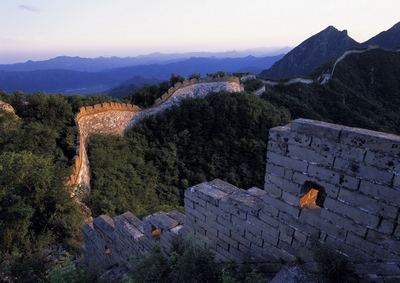
The Great Wall, like the Pyramids of Egypt, the Taj Mahal in India and the Hanging Garden of Babylon, is one of the great wonders of the world. Starting out in the east on the banks of the Yalu Rivers in Liaoning Province, the Great Wall stretches westwards for 12,700km to Jiayuguan in the Bobi Desert, thus known as the Ten Thousand Li Wall in China. The Great Wall climbs up and down, twists and turns along the ridges of the Yangshan and Yinshan Mountain Chains through five provinces - Liaoning, Hebei, Shanxi, Shaanxi, and Gansu - and two autonomous regions - Ningxia and Inner Mongolia, binding the northern China together. Along the total length of the great wall around Beijing, there are major eight sections including Badaling, Juyongguan, Huanghuacheng, Jiankou, Mutianyu, Gubeikou, Jinshanling, and Simatai.
Beijing Badaling Great Wall
Most of The Great Wall that we see today dates back to the Ming Dynasty. The best-preserved and most imposing section is at Badaling near Beijing city. This section, located at the head of the Juyongguan Pass, is made of large blue bricks and has an average height of 7.8 meters. Five to six horses can be ridden abreast along it. At regular intervals there is an arched door giving access to the top of the wall. The walls feature regular lookout holes, window embrasures and castellated crenels. Beacon towers for passing on military information also appear at fixed intervals. All of these emphasize the important role of the Great Wall in military defense.
Only 70km away by superhighway, Badaling is the closest section of the Great Wall to Beijing and can be visited in half a day. Moreover, its proximity to the Ming Tombs means both sites can be seen in a single outing. Badaling was completely restored after 1957. It has a chairlift and fast food restaurants and can be very crowded with hawkers and tourists.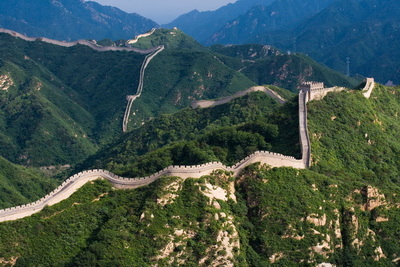
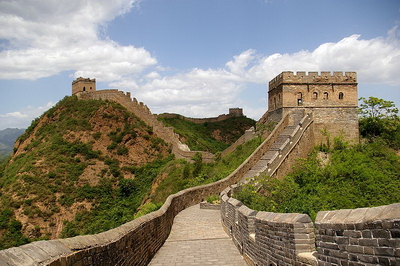
Juyongguan Great Wall in Beijing
JuYongGuan Great Wall is a pass ('guan' means 'mountain pass') through the mountains located in an 18 km long valley named GuanGou which is in ChangPing County, more than 50 km from Beijing City. JuYongGuan is one of the three greatest passes of the Great Wall of China. The other two are JiaYuGuan Pass (Gansu Province) and ShanHaiGuan Pass (Hebei Province). JuYongGuan Great Wall raises steeply each side of a fortified gate. There is a temple and other attractions close by. JuYongGuan Great Wall also features some life-size Terracotta Warriors.
In the middle of JuYongGuan Great Wall, in the valley, there is 'Cloud Platform' (also called 'Crossing Street Tower'). It was made of white marble during the Yuan Dynasty and has a height of 9.5 m. In the middle of the base of the platform there is an arched doorway. Many animal images were carved both in the arch and the door. On the walls to each side of the door, the statues of gods and scriptures were carved. The presently seen JuYongGuan Great Wall was initially built in the Ming dynasty and received much renovation later. It is a very important strategic place connecting the inner China and the area near the northern border. JuYongGuan Great Wall was also of great defensive importance for Beijing city.
Beijing Mutianyu Wall
Mutianyu is located some 90km north of Beijing, and like Badaling, is a recently renovated section that's very popular. Mutianyu lies in rugged territory and reaching the Wall from the main gate involves a strenuous climb up a steep stairway, but fortunately there's a chairlift. Once on top, the views of the Wall undulating down wooded canyons and up mountain ridges are breathtaking.
Beijing Simatai Great Wall
Simatai, a section of the Great Wall of China located in the north of Miyun County, 120 km northeast of Beijing, holds the access to Gubeikou, a strategic pass in the eastern part of the Great Wall. Originally built during the Northern Qi dynasty (550-577) and rebuilt in the Hongwu years of the Ming dynasty by Qi Jiguang, this section of Great Wall is one of the few to retain the original features of the Ming dynasty Great Wall.
Simatai Great Wall is 5.4 km long with 35 beacon towers. This section of the Great Wall incorporated the different characteristics of each section of the Great Wall. A specialist on the Great Wall, Professor Luo Zhewen, has said "The Great Wall is the best of the Chinese buildings, and Simatai is the best of the Great Wall." UNESCO has designated Simatai Great Wall as one of the World Cultural Heritage sites. Hanging precariously onto the Yanshan Mountain, Simatai Great Wall is known for its steepness.
Simatai Great Wall is separated by a valley into eastern and western parts. The western part appears gentle with 20 well-preserved watchtowers dotting along the wall. The eastern part is much steeper, following more rugged terrain that includes cliff edges and kilometre-high peaks. The 15 watchtowers are relatively closely spaced and provide spectacular views. Main attractions in the eastern part include Watching Beijing Tower, Fairy Tower, Heavenly Ladder and Sky Bridge, though they are currently closed to the public for safety reasons. A popular hike is to traverse from JinShanLing to Simatai.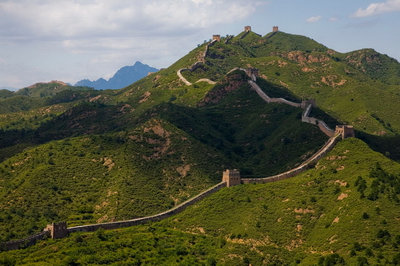
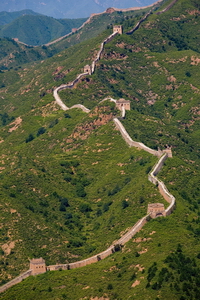
Beijing Jinshanling Wall
Jinshanling, a section of the Great Wall of China located in the mountainous area in Luanping county 125 km northeast of Beijing. This section of the wall is connected with the Simatai section. It was built from 1570 during the Ming Dynasty.
The Jinshanling section of the Great Wall is 10.5 km long with 5 passes, 67 towers and 2 beacon towers. The initial section of the wall has been restored to original condition, but the condition of the wall deteriorates towards its natural state as it approaches Simatai. The entrance fee is 40 yuan. A cable car has been constructed to take visitors to the highest point along the wall. There is an additional admission charge of 50 yuan to continue on to the Simatai section, and a 5 yuan fee to cross the suspension bridge.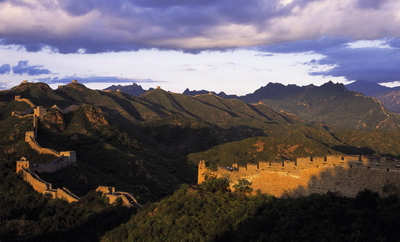
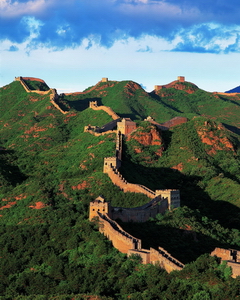
Huangyaguan Pass of Great Wall
Located in the mountainous area of Tianjin's northern Ji County, the Huangyaguan Pass of Great Wall was first built during the Northern Qi Dynasty (550-557) and repaired in large scale with bricks during the Ming Dynasty (1368-1644). When appointed as the chief commanding officer in the Ji Garrison (one of the eleven garrisons of the Ming Dynasty), Qi Jiguang added watch towers and other defensive works. Huangya, means "yellow cliff". The pass takes this name from the yellowish hills and rocks nearby. Originally built in Tianbao 7th of Beiqi (557 A D), the Huangyanguan was repaired for the first time in Ming Dynasty with bricks and for the second time in 1985. In 1986 it was listed as a key relics protection target of Tianjin city.
The Huangyaguan Pass comes out first in the ten most-visited sites in Tianjin. It is considered to be a miniature of the Great Wall of China. The entire section is built on an abrupt mountain ridge. Being endowed with both natural beauty and cultural interest, it has become famous as a natural beauty spot and a summer resort. The major scenic area is composed of Huangyaguan Pass and Taiping Mountain Stronghold.
In 1984, the people of Tianjin spent three years repairing 3,308 yards of the main wall from Banlagang Mountain in the east to Wangmaoding Mountain in the west. They restored 20 terraces, the Huangya Water Gate, and the Bagua Castle (the Eight Diagrams Castle). The defensive system of the wall is complete. Watch towers, frontier cities, drain holes, emplacements, barracks and other indispensable military facilities are arranged orderly along the wall. Besides, the stele forests of the Great Wall, Beiji Temple, the exhibition hall of famous couplets, the Great Wall Museum (the first museum along the Great Wall) and the Phoenix Fortress have been newly built within the area. Six miles northwest of Huangyaguan Pass and built 437 yards to 547 yards above sea level, the stronghold is located in Xiaopingan Village. It controls the Chongshan Valley east of Huangyaguan Pass City. Qi Jiguang's stone statue and a tower were erected by twelve widows from this area.Huangya Great Wall welcomes tourists from all over the world, including many runners, who participate in the annual international marathon race.
China Trip Planner | Travel Agents | About Us | Why Us | Contact Us | How to Pay | How to Book - Terms & Conditions | Site Map
Copyright © 2010 - 2030 All Rights Reserved.


 0086-28-85711328
0086-28-85711328 0086-28-85546015
0086-28-85546015



